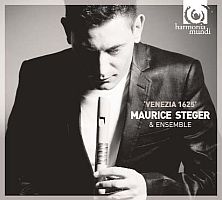
New Vistas
Music from Venice -
enjoyed by
GEORGE BALCOMBE'... a pastoral softness ...'
|

|
Maurice Steger is a recorder virtuoso who, on this CD of Venezia 1625 directs an ensemble of Early Music instruments, which were recently built to replicate masterpieces by seventeenth century instrument makers.
Listen -- Merula: Chiaccona
(track 7, 0:00-0:49) © 2009 harmonia mundi sa
Masters of another kind are also heard on this CD, and they are seven prominent composers of seventeenth century Italy who astonished Venice around 1625. They still amaze listeners today, but this time, thanks to Maurice Steger, the leading violins are replaced by Steger's own variously-pitched consort of recorders. The ensemble directed by Steger provides a versatile accompaniment for two recorders.
Around 1600 a new word -- Sonata -- spread across Europe. It simply meant a style of music played by instruments only, with no singers. By 1625 the sonata instrumentation formalised into treble, tenor and bass. Within any one of these groups, the instruments frequently swapped over with each other. For example, the violins' string part could be played by the woodwind recorder. And that is what recorder virtuoso Maurice Steger does on this CD.
Listen -- Fontana: Sonata III a Violino solo
(track 5, 0:01-0:59) © 2009 harmonia mundi sa
By 1625 a throng of celebrated Italian musicians filled the Basilica of St Mark with an unbelievable splendour of sound.
As Master of the Chapel, Monteverdi wrote brilliant church music while the Gabrielis produced overwhelming music for brass, such as the now popular pian-e-forte.
So, from St Mark's Chapel, new music evolved, not only for the great Chapel's usual musical forces, but also for the smaller groups, such as the ensembles which became the principal performers of the instrumental sonatas.
The new music, while not itself liturgical, had emanated from St Mark's Chapel and inherited a 'grave and imposing' style, which was offset by rapidly-played canzonas.
These conventions of early baroque sonatas provide the basic structure of this CD. So the Italian composers in 1625 Venice have been chosen not only to illustrate but primarily what the sonatas sounded like over four hundred years ago. We, today's listeners, are being reminded that these early Venetian sonatas eventually led to Sonata Form in the late eighteenth century and on to the whole fabric of classical music still active into the 21st century. It might be said that the only thing in common between the sonatas of 1625 Venice and the music of Sonata Form is that both were performed solely by instruments.
Some of the other works are not labeled sonata at all. For instance, Marco Uccellini (1603-1680) has Symphonia XX, La Vermingarda; Tarquinio Merula (1590/95-1665) has Chiaconna a Canzone a due violini and Canzon La Pighetto; and Alessandro Piccinini (1566-1638) has Toccata and Intavolatura di Chitarrone.
However, unlike the yet-to-come centuries of the inviolable discipline known as Sonata Form, the early baroque sonatas indulged in free-form which sent the performers leaping from the solemn to the frivolous, from highest to lowest notes and to capers with tempi and dynamics.
Listen -- Uccellini: Sonata II detta la Luciminia contenta a violino solo
(track 18, 1:43-2:41) © 2009 harmonia mundi sa
Maurice Steger, armed with his own consort of variously-pitched recorders, admirably fills the space otherwise occupied by virtuosic violins. The Early Music instruments of the ensemble performers have a pastoral softness perfect for the songbird sweetness of the recorder.
The CD and booklet of Venezia 1625 have opened new vistas of early baroque Venice. Our view of the Serene Republic can never be the same again.
Copyright © 9 November 2009
George Balcombe,
London UK
 CD INFORMATION: VENEZIA 1625 - MAURICE STEGER AND ENSEMBLE
CD INFORMATION: VENEZIA 1625 - MAURICE STEGER AND ENSEMBLE
| 
